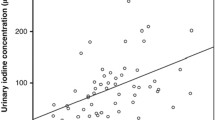Abstract
Urinary iodine excretion was assessed in 642 healthy children aged 10 mo (n=243), 2 yr (n=183), and 4 yr (n=216) living in the Paris area and originating from continental France (60.3%), North Africa (13.8%), the West Indies (9.1%), West Africa (8.3%), Southeast Asia (4.8%), and southern Europe (3.8%). Mild impairment of neurological (reflexes, tone, audiometry) and intellectual development (Brunet-Lézine scale) was assessed in relation to iodine status. Iodine excretions (median values) were 18.4, 11.9, and 10.9 μg/100 mL at 10 mo, 2 yr, and 4 yr, respectively, and risk of mild iodine deficiency (5–10 μg/100 mL) was 18.1%, 34.8%, and 38.3% for the same age groups. No relationship was found between anthropometry, global development quotient, and iodine status. High hearing thresholds were more commonly associated with lower iodine excretion, suggesting mild hearing defects. In spite of iodine prophylaxis, the risk of mild to moderate iodine deficiency still exists in France and in a number of European countries. Evaluation of neurological sequels of borderline iodine status is a major public health problem in European communities.
Similar content being viewed by others
References
UNICEF,The state of the World's Children 1990, Oxford University Press, New York, (1990), p. 102.
F. C. Kelly and W. W. Snedden,W.H.O. Monograph Series 44, 27–241 (1960).
B. E. Brush and J. K. Atland,J. Clin. Endo. Metab. 12, 1380 (1952).
Subcommittee for the Study of Endemic Goitre and Iodine Deficiency of the European Thyroid Association,Lancet 1, 128 (1985).
B. S. Hetzel,The Prevention and Control of Iodine Deficiency Disorders, B. S. Hetzel, J. T. Dunn, and J. B. Stanbury, eds., Elsevier, Amsterdam (1987) pp. 7–31.
M. Riley and A. Gochman, A fully automated method for the determination of serum protein bound iodine, Technicon Symposium, New York (1964).
Y. Y. Wang and S. H. Yang,Lancet 2, 518 (1985).
O. Brunet and I. Lézine, Développement psychologique de la première enfance, PUF, Paris (1951).
C. H. Thilly, P. Bourdoux, B. Contempre, and B. Swennen,L'enfant en Milieu Tropical,175–176, p. 70 (1988).
J. B. Stanbury,The Prevention and Control of Iodine Deficiency Disorders, B. S. Hetzel, J. T. Dunn and J. B. Stanbury, eds., Elsevier, Amsterdam (1987) pp. 35–47.
R. Mornex,Bull. Acad. Natle Med. 171, 301 (1987).
B. M. Goslings, R. Djokomoeljanto, R. Hoedijono, H. Soepardjo and A. Querido,Acta Endo. 78, 705 (1975).
M. Koenig and M. Neiger,Adv. Exp. Med. Biol. 30, 325 (1972).
Author information
Authors and Affiliations
Rights and permissions
About this article
Cite this article
Valeix, P., Preziosi, P., Rossignol, C. et al. Iodine intakes assessed by urinary iodine concentrations in healthy children aged ten months, two years, and four years. Biol Trace Elem Res 32, 259–266 (1992). https://doi.org/10.1007/BF02784609
Received:
Accepted:
Issue Date:
DOI: https://doi.org/10.1007/BF02784609




